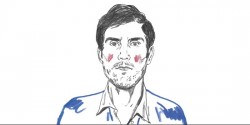Tuesday through Sunday from 12:00 until 21:00
Closed Monday
Admission is Free


Sitting at lunch the other week, in a rainy London, I let my mind drift to Venice. I was to visit the city for the Biennale — that greatest of arts festivals. One that, in its opening days, seems to take over the entire city. As well as the main shows and national pavilions, pop-up exhibitions of varying sizes are everywhere. Houses are taken over by ‘art collectives’ and churches are given over to secular postmodernism. Dragging myself back to the room, I said to my hostess that I’d be going there. It emerged that she’d visited the city in the early 1960s with her friend Truman Capote. She related all of this in her southern drawl. They’d come for the Biennale and were walking past the Lido when they saw a macabrely thin woman about to swim. ‘That’s a monster!’ said Capote. ‘No, that’s anorexia nervosa,’ said my friend Marguerette. ‘Oh Marguerette,’ said Capote, ‘you know everyone!’
The best time to visit the Biennale is not during the opening: that’s a social rather than a cultural event. The moment you step off the vaporetto it’s upon you — art-world flâneurs clutching iPhones, trying to figure out whether they should have drinks at the Gritti or the Bauer. Every night there are dinners and parties given for artists by curators, collectors and dealers, so everyone comes down with that art-world malady, ‘Fomo’ (Fear of Missing Out). Far better, I think, to come later in the summer, when people wear bum bags and T-shirts rather than the black uniform that the art world dons regardless of the weather.
The theme of this year’s Biennale is ‘the encyclopaedic palace’: a fantasy museum that hold records of all human endeavour and achievement — which means a great deal of work by ‘outsider’ artists in the main show at the Arsenale. It is variety that seems to be the differentiator of this year’s Biennale.
Around town, the Tapies show — which includes work by the Catalan artist as well as works he owns by other artists — at the beautiful Palazzo Fortuny is worth seeing for the imaginative presentation alone. The Anthony Caro show at the Museo Correr gives us an opportunity to reconsider this important British sculptor. Lynette Yiadom-Boakye, who won the 2012 Future Generation Art Prize and has been nominated for this year’s Turner Prize, is a new talent about whom people seem excited. She is not the creator of video or installation art but a painter — something of a novelty here. Her work forms part of a larger show at the Pinchuk Foundation’s space at the Palazzo Contarini Polignac on the Grand Canal.
The social side of art collecting is most visible in Venice. I saw Leonardo -DiCaprio at Harry’s Bar. The art world has an amazing ability to play on the insecurities of the rich and famous; what art you own can be an indicator of intellect and sophistication, perfect for the thespian with low self-esteem. Everyone has the same conversation at these Venice shindigs: What did you see today? And what do you like?
Sitting opposite a very nice but very LA woman at a dinner for an American artist, I tried explaining that I was collecting less contemporary art and more historic art. You mean old art, she said, seeming to have no concept of any art history predating Andy Warhol. She kept talking about hip young LA artists and I was trying to tell her about Sickert’s Camden Town paintings; we might as well have been speaking different languages. We both pretended to know about the other person was talking about. When asked what she thought of Caro’s work, she said, ‘I know what her work means to me, what does it mean to you?’ She’s great, I said, as the main course arrived at 11.30 p.m.
But then, after seeing the work of hundreds of artists in one day, you need a bit of light relief. If you walk around the city bah-humbugging about the triviality of some of the pieces and the idiocy of the people, then you are missing the point. True, much of today’s new art is superficial and vacuous, but then that’s because we in the West live in decadent, twittering times. If this is the end — or at least the near end — of an overheated art market, then we might as well enjoy ourselves. This Venice crew might be fiddling while the town burns, but I for one would rather fiddle than burn.
And if you don’t like contemporary art then you can see the excellent Manet show — better than the one we had in London.
Portrait: David Sparshott
This article first appeared in the print edition of The Spectator magazine, dated 22 June 2013